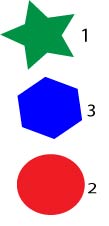Skip over navigation
My coat has three different buttons.
Sometimes, I do them up starting with the top button. Sometimes, I start somewhere else.
How many ways can you find to do up my coat?
How will you remember them?
Do you think there are any more? How do you know?





Or search by topic
Number and algebra
Geometry and measure
Probability and statistics
Working mathematically
Advanced mathematics
For younger learners
Button-up
Age 5 to 7
Challenge Level 





- Problem
- Getting Started
- Student Solutions
- Teachers' Resources
Button-up
My coat has three different buttons.
Sometimes, I do them up starting with the top button. Sometimes, I start somewhere else.
How many ways can you find to do up my coat?
How will you remember them?
Do you think there are any more? How do you know?
This problem was inspired by an idea of Bernard Murphy.
Why do this problem?
Young children often find working in a systematic way very difficult. This problem gives a real context and an opportunity to record, leading to the very beginnings of proof.
Possible approach
Have available a selection of objects which the children could choose to use to represent buttons.
You may wish to introduce the problem using your own coat/jacket, or that of a child. Button it up in two different ways and ask the children what was different. Listen for comments to do with the order of buttoning. Ask the children how we could remember what was different. Invite them to talk in pairs about what they would do and then share the children's ideas
about recording.
Pose the problem as suggested and invite the children to work in pairs to solve it. As the children are working, look out for a pair that has developed a useful recording method. Ask them to copy each solution on to a separate large piece of paper, ready for use with the whole class. (Alternatively if you have an interactive whiteboard, you could ask the pair to record
their solutions as separate draggable objects.)
After a suitable length of time, bring the whole group together. Invite enough children to hold all the big pieces of paper at the front and ask whether we have found all the different ways of buttoning. How do we know? Is there any way of rearranging the pieces of paper to help us be sure?
Give the children the chance to repeat the rearranging activity with their own way of recording.
Key questions
What could you change about the buttoning?
Do you always have to start in the same place?
How will you remember the ways you've found?
Is your recording different to other people's?
Possible extension
You may like to look at the follow-up to this problem, Button Up Some More, which encourages children to look at having more buttons.
Possible support
Some children may have difficulty with the recording of this activity. This is likely to stem from the fact that the most obvious way of recording implies that the buttons move. For example, buttoning green then red then blue could be recorded on the coat as:

Or:

which implies that the buttons have moved.
You may also like
Plants
Three children are going to buy some plants for their birthdays. They will plant them within circular paths. How could they do this?
Triangle Animals
How many different ways can you find to join three equilateral triangles together? Can you convince us that you have found them all?
Junior Frogs
Have a go at this well-known challenge. Can you swap the frogs and toads in as few slides and jumps as possible?

